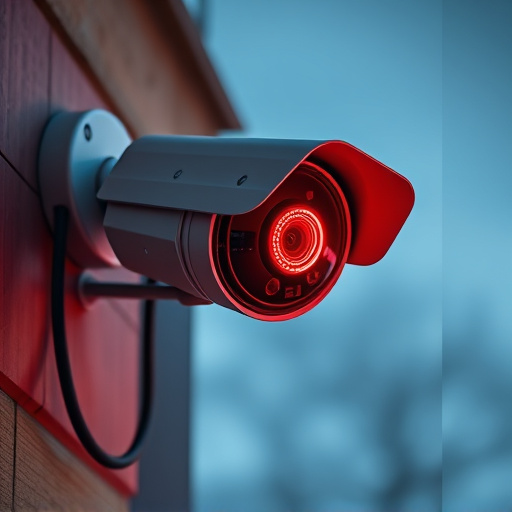The market for Blinking LED Fake Security Cameras has seen significant growth due to their cost-effectiveness, DIY installation, and realistic features like motion detection. These cameras offer an affordable security solution, appealing to both residential and commercial customers looking to mimic traditional CCTV systems without major investments. With advanced design and technology, they serve as effective deterrents for potential intruders across various sectors, from retail to law enforcement training. However, their increasing misuse raises legal and ethical concerns regarding privacy protection and the potential for abuse.
“Unveiling the intriguing world of realistic fake surveillance equipment, particularly Blinking LED Fake Security Cameras, this article explores a unique blend of technology and deception. The market for these simulated cameras is growing, offering an array of applications from security testing to creative filmmaking. We delve into the design intricacies, revealing how advanced LED technology creates convincing visual effects. Additionally, we examine legal boundaries and ethical considerations surrounding their use, providing a comprehensive guide to this fascinating and sometimes controversial topic.”
- Understanding the Market for Fake Surveillance Equipment
- Design and Technology Behind Blinking LED Cameras
- Applications and Use Cases of Realistic Fake Security Cameras
- Legal Considerations and Ethical Implications
Understanding the Market for Fake Surveillance Equipment
The market for fake surveillance equipment, particularly blinking LED fake security cameras, has seen a surge in demand over recent years. This trend is driven by a mix of factors, including cost-effectiveness and the appeal of an easy, DIY security solution for both residential and commercial properties. Blinking LED cameras offer a realistic alternative to traditional CCTV systems, appealing to consumers looking for a discreet and affordable way to enhance their security without major investments.
This growing market caters to a diverse range of customers, from individuals seeking basic home protection to businesses aiming to deter potential thieves or vandals. The accessibility of these fake surveillance devices, often available online at competitive prices, has contributed to their widespread adoption. Moreover, the realistic design, including features like motion detection and infrared capabilities, makes them almost indistinguishable from genuine security cameras, adding to their appeal for those looking to maintain a high level of privacy without compromising on security measures.
Design and Technology Behind Blinking LED Cameras
The design and technology behind blinking LED fake security cameras have evolved significantly, making them increasingly realistic and effective deterrents for potential intruders. These cameras mimic the appearance of traditional CCTV systems with intricate detail, from the housing to the lens and light sensors. The use of high-resolution LEDs allows for a dynamic display, simulating genuine camera activity by mimicking the blink rate and intensity of real security lights. This visual deception is crucial in deterring crime, as it creates the illusion of constant surveillance.
The advanced technology doesn’t stop at the visual. These cameras are often equipped with motion sensors that activate the blinking pattern when any movement is detected, further enhancing their realism. The sensors respond swiftly, ensuring a natural and unscripted sequence of lights, just like real security systems. Additionally, some models incorporate low-light performance features, enabling them to operate efficiently even in dimly lit environments, making them versatile for various outdoor and indoor applications.
Applications and Use Cases of Realistic Fake Security Cameras
Realistic fake surveillance equipment, such as blinking LED fake security cameras, offers a variety of innovative applications across different sectors. These mimic genuine security cameras, providing an effective deterrence against potential criminals in public spaces, private properties, and critical infrastructure sites. By strategically placing these lifelike replicas, businesses, and organizations can enhance their overall security posture without the need for extensive and costly physical camera installations.
Use cases extend from retail stores aiming to prevent shoplifting to residential areas using them as a visual deterrent against burglaries. In event management, realistic fake cameras can help maintain crowd control and ensure safety during large gatherings. Additionally, these cameras are valuable tools in surveillance training, allowing law enforcement agencies to simulate real-world scenarios without the risks associated with live operations.
Legal Considerations and Ethical Implications
The proliferation of realistic-looking fake surveillance equipment, such as blinking LED fake security cameras, raises a plethora of legal and ethical considerations. While these devices may appear to be legitimate security solutions, their use can blur the lines between privacy protection and potential invasion. Legally, many countries have strict regulations regarding video surveillance, often mandating clear notification of camera presence and adhering to specific data collection practices. The use of fake cameras could lead to legal repercussions if not properly disclosed, as it may mislead individuals into believing they are under constant observation.
Ethically, the implications are equally profound. Fake security cameras can foster a sense of mistrust and paranoia, impacting community relations and mental well-being. Moreover, their unrestricted availability might enable malicious actors to engage in surveillance abuse, compromising privacy rights without consequence. As technology advances, it becomes increasingly vital to strike a balance between enhancing security measures and preserving individual freedoms, ensuring that the use of fake surveillance equipment does not outweigh the potential harm it may cause.
The market for realistic-looking fake surveillance equipment, particularly blinking LED fake security cameras, has evolved significantly. These devices offer unique applications ranging from deterring crime to enhancing privacy and decor. However, it’s crucial to balance the benefits against legal considerations and ethical implications. As technology advances, understanding the nuances of these cameras becomes essential to ensure responsible usage in an increasingly surveillance-conscious world.
